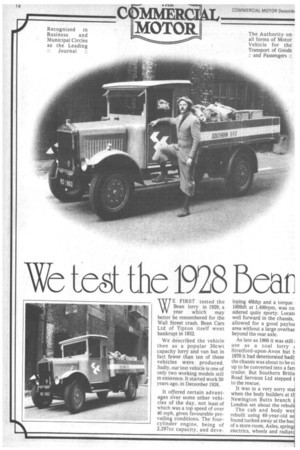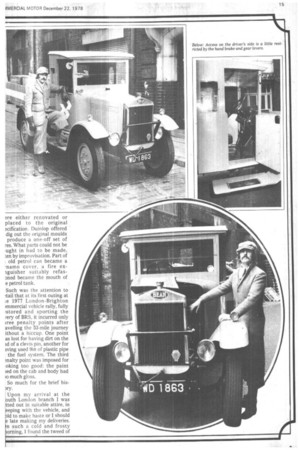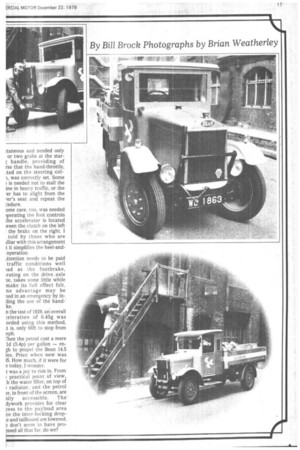Wc tc8t ±0 1928 ncar
Page 16

Page 17

Page 18

Page 19

If you've noticed an error in this article please click here to report it so we can fix it.
WE FIRST tested the Bean lorry in 1929, a year which may better be remembered for the Wall Street crash. Bean Cars Ltd of Tipton itself went bankrupt in 1932.
We described the vehicle then as a popular 30cwt capacity lorry and van but in fact fewer than ten of these vehicles were produced. Sadly, our test vehicle is one of only two working models still in existence. It started work 50 years ago, in December 1928.
It offered certain advantages Over some other vehicles of the day, not least of which was a top speed of over 40 mph, given favourable prevailing conditions. The fourcylinder engine, being of 2,297cc capacity, and deve _ loping 46bhp and a torque 1001bft at 1,400rpm, was co sidered quite sporty. Locati well forward in the chassis, allowed for a good payloz area without a large overhar beyond the rear axle.
As late as 1960 it was still I use as a coal lorry z Stratford-upon-Avon but t 1970 it had deteriorated bad!: the chassis was about to be ci .up to be converted into a fani trailer. But Southern Britis Road Services Ltd stepped i to the rescue.
It was in a very sorry sta when the body builders at tINewington Butts branch i London set about the rebuil( The cab and body wer rebuilt using 40-year-old as found tucked away at the bac of a store room. Axles, spring electrics, wheels and radiatc ere either renovated or placed to the original ecifkation. Duinlop offered dig out the original moulds produce a one-off set of res. What parts could not be lught in had to be made, ten by improvisation. Part of old petrol can became a rnamo cover, a fire exiguisher suitably refasoned became the mouth of e petrol tank.
Such was the attention to !tail that at its first outing at ie 1977 London-Brighton nnmercial vehicle rally, fully stored and sporting the Tery of BRS, it incurred only tree penalty points after avelling the 53-mile journey ithout a hiccup. One point as lost for having dirt on the kl of a clevis pin, another for wing used 9in of plastic pipe the fuel system. The third malty point was imposed for ,oking too good: the paint Jed on the cab and body had io much gloss.
So much for the brief his Upon my arrival at the outh London branch I was tted out in suitable attire, in eeping with the vehicle, and Dld to make haste or I should e late making my deliveries. Pn such a cold and frosty iorning, I found the tweed of my jacket and plus-fours w mirably suited to combattir the icy draughts of the ca which had no side windows.
Windscreen wipers were ni a feature of this model. I wz glad it was not raining, as ti method of obtaining a del view of the road ahead undi such conditions is to angle tF top section of the screen. Th does, however, present certai disadvantages, namely a cob wet blast of air from the frot in addition to the unprotecte areas at the sides. But in oth( respects the vehicle proved t be surprisingly comfortabl even when driving over cot blestones, which are still to b found in some areas of Lor don's East End. The ride di not deteriorate as much as had expected but by moder standards it would be unac ceptable for the normal woi king day.
Although the steering wa heavy with the vehicle a a standstill, it became prc gressively lighter as the spee was increased. Due to a poc lock however, it was not ur common to have to shunt t negotiate tight corners o narrow roads. Gear changin is best made by a smooth swil movement of the lever, corn plicated slightly by the shit across the gate from second t third of the indirect ratios.
The driving position is cotr fortable unless there is mor than one passenger carried, i which case one has to positio oneself well to the side of th vehicle, bringing both th gearstick and the handbrak lever in close proximity t one's legs. This, it must be ad mitted, does restrict thei operation.
Starting proved almost in itaneous and needed only or two grabs at the star; handle, providing of rse that the hand-throttle, Lted on the steering coi1, was correctly set. Some ; is needed not to stall the me in heavy traffic, or the 'er has to alight from the rer's seat and repeat the cedure.
°me care, too, was needed iperating the foot controls the accelerator is located ween the clutch on the left . the brake on the right. I told by those who are iiliar with this arrangement t it simplifies the heel-and operation.
Artention needs to be paid traffic conditions well !ad as the footbrake, rating on the drive. axle ne, takes some little while make its full effect felt. ne advantage may be ned in an emergency by inding the use of the hand: ke.
n the test of 1929, an overall .:eleration of 0.45g was .orded using this method, it is, only 66ft to stop from nph.
Chen the petrol cost a mere id (5.4p) per gallon — engh to propel the Bean 14.5 les. Price when new was )5. How much, if it were for e today, I wonder.
t was a joy to ride in. From ! practical point of view, :h the water filler, on top of ! radiator, and the petrol er, in front of the screen, are sily accessible. The dywork provides for clear cess to the payload area ce the inter-locking drope and tailboard are lowered.
don't seem to have pro?ssed all that far, do we?




































































